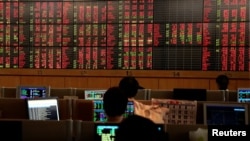Indicators as diverse as movie ticket sales and airport arrivals reinforce the view that a recession is under way in some Southeast Asian economies and imminent in others, due in large part to COVID-19.
All but two of the 10 nations in the region will see negative growth in gross domestic product this year, according to data compiled by Capital Economics, a research company. Vietnam and Myanmar are the exceptions, while Singapore’s GDP already contracted in the first quarter, and Thailand, Malaysia and the Philippines will see the biggest economic losses of 2020. The data mark a sharp change of fortune for the once fast-growing economies, which are key to global supply chains.
Overall GDP will decrease by about 10% in Southeast Asia this year, compared with the increase of close to 5% last year, Capital Economics forecast.
“COVID-19 has hit us in a very hard way,” Philippine Finance Secretary Carlos Dominguez said earlier this month. He explained the need for the government to provide economic aid to citizens, saying, “So the program is to spend, first, to help the poorest families, and then to help the small and medium enterprises, and then to provide support for the companies that are supported by their banks.”
The decrease in travel, exports like component parts, and remittances from the Philippine diaspora is hurting the economy. The nation also has the strictest lockdown rules in the region, including arrests of violators, which will affect the Philippine’s ability to rebound, economists say.
These are some of the problems that are common across the region, as much of Southeast Asia has tropical climates that attract tourists as big shares of their economies, as well as key locations important to global trade, shipping goods from China and their own nations around the world. That makes trade-fueled economic growth a main tool that developing nations in Southeast Asia were using to move up to middle-income status.
Add to that the instability in the oil sector, which saw the price per barrel decrease into negative territory, first because COVID-19 decreased demand for fuel, and then because of the supply war between Saudi Arabia and Russia. The plummeting prices hurt three economies in Southeast Asia: Malaysia, Indonesia, and Brunei, which collect state revenues from oil exports.
“Association of Southeast Asian Nations (ASEAN) economies are better prepared than they were in the Asian Financial Crisis that hit the region more than two decades ago, with larger foreign exchange reserves and overall better macroeconomic positions compared to their situation in the late 1990s,” Amy Searight said in an analysis for the Center for Strategic and International Studies think tank, where she is a senior adviser. “However, the economic shock from COVID-19 may be deeper and longer lasting.”
Senior Asia economist Gareth Leather at Capital Economics looked at proxies for economic activity to gauge the impact of the virus. Beyond the traditional data on factory output and currency rates, he examined movie theater ticket sales, for instance. In Indonesia, Malaysia, the Philippines and Thailand, they were valued at more than $20 million in March 2019; last month they dropped off a cliff, approaching zero.
For many ASEAN members this year’s gloomy forecast represents the worst economic performance in decades. Most have introduced economic relief packages in response to the virus, including cash aid to families, tax breaks to businesses, and corporate loans.
Those come from the government but some in the private sector are making similar moves. In Singapore, Cisco introduced a financing program for customers, which typically go to the company for products such as computer networking equipment. The program allows them to defer payments in many cases until next year.
This is part of the company’s “commitment to playing our role in helping businesses and our partners in Singapore during these tough times," Andy Lee, managing director at Cisco in Singapore, said.




